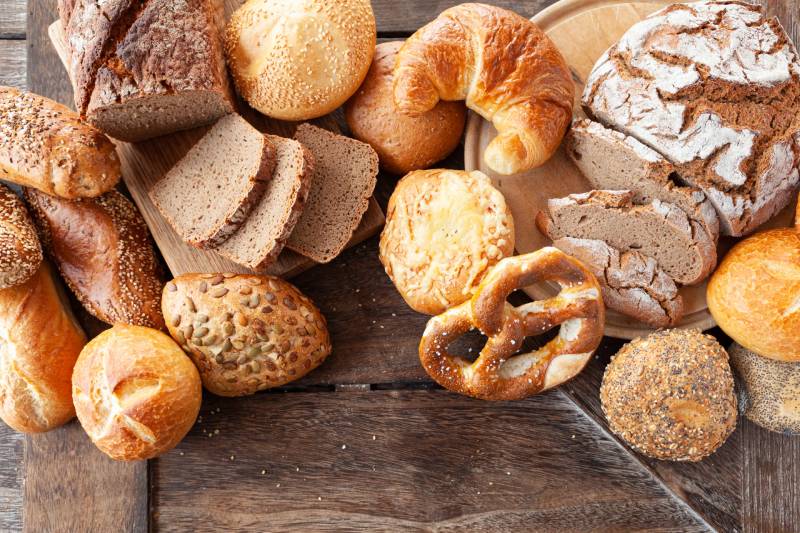Festivals & Events
Interesting and Amazing Facts about German Bread Culture

Today’s Google slideshow Doodle honors Germany’s distinctive bread culture and history! Pumpernickel, get out of the way. This is your moment to shine. German bread culture is honored in this Doodle, which was illustrated by guest artist Joe Villion, who is based in Berlin. German bread comes in a variety of delectable varieties to suit every palate, including Almbrot, Dinkelvollkornbrot, Krüstchen, and Zwiebelbrot for example. On December 12, 2014, the National Commission for UNESCO added “German bread culture” to the National Register of Intangible Cultural Heritage.

35 Interesting Facts about German Bread Culture
- German bread is prized for its distinctive diversity everywhere in the world. The journeymen and master pass on to the apprentice their knowledge of baking techniques, ingredients, and customs from generation to generation. The most recent ideas and methods are combined with centuries-old customs in the baking craft.
- German bread is well-known and loved all over the world; what distinguishes it most is the variety of bread varieties. German bread culture was added to the country’s inventory of intangible cultural heritage in 2014 by the German Commission for UNESCO.
- Because German bread culture is so distinctive and varied, it was designated as an intangible cultural heritage by UNESCO in 2014. Long-standing customs are upheld today, preserving the bread’s high caliber and diversity. Furthermore, because of ongoing scientific discoveries, new elements are constantly being incorporated into the process.
- The primary cause of the regional variation in bread products is the limited availability of raw materials during difficult times, which forced bakers to continuously demonstrate their inventiveness and creativity.
- Niedersachsen (Lower Saxony) is known for its traditional bread specialties, which include the unique Springbrötchen (literally, “cracked rolls”) from Osnabrück, which is a type of rye bread, and “Gerster Brot,” which is a special variation of “Doback” (twice-baked bread), also known as East Frisian Black Bread.
- German bread culture is also associated with certain unique customs and traditions, such as the custom of welcoming guests into a new home with bread and salt. In addition to being believed to ward off evil spirits, bread and salt are symbols of prosperity and happiness.
- The historical roots of Germany’s regional bread diversity can be found in the unique soil and climate, as well as in the country’s political, historical, and geographical developments.
- The bakers had to repeatedly demonstrate their inventiveness and resourcefulness because of resource scarcity, difficult times, environmental factors, and wars.
- In social interactions as well as in domestic and family settings, bread appreciation holds a unique position. Common bread consumption frequently gives name to friendly gatherings like the evening meal (German: “Abendbrot,” literally “evening bread”).
- Additionally, bread plays a significant role in Christian and bourgeois customs and figures of speech. For example, during the Eucharist, bread represents the body of Christ, and during the Harvest Festival, bread is thought to represent gratitude for a bountiful harvest.
- When they move in, new neighbors are frequently given bread and salt as a token of good wishes for their future.
- Few other countries can match this diversity of options. There are an estimated 3,200 different types, according to the Central Association of the German Bakery Trade. But the most well-liked are the timeless pieces: breads with grains and seeds, wholegrain breads, breads made with a blend of wheat and rye flour, and breads that are toasted.
- Bread is a staple food for Germans, whether it is consumed for breakfast or the traditional “Abendbrot,” or “evening bread,” dinner. Every household consumes about 56 kilograms of bread and bakery products annually on average, according to the Central Association of the German Bakery Trade.
- By the end of 2022, there were about 9,600 master bakeries and 35,000 shops in Germany. With 450 years of history, a bakery in the Bavarian town of Kemnath is believed to be the oldest in all of Germany.
- Typically, sommeliers are experts in wine. However, some people possess “everything about bread” knowledge and are certified bread sommeliers. Originally from Lower Franconia, Axel Schmitt is one of the first and most famous bread sommeliers. His research project involved examining the effects of loud music on the acidity of sourdough. He was dubbed the “Wacken Baker” by the organizers of the renowned outdoor heavy metal music festival in Wacken.
- One of the earliest types of bread is the Westphalian black bread known as pumpernickel. The origin of the name is unknown. One of the most widely accepted legends links the name to Napoleon Bonaparte. It seems that his soldiers called the bread “bon pour Nickel,” which translates to “good for Napoleon’s horse Nickel.” Even though this myth has been disproved, one of Germany’s most well-known breads is still pumpernickel.
- Not only does bread play a big role in German cuisine, but it also practically keeps their culture alive. There are 3,200 officially recognized varieties of bread in Germany, according to the German Institute of Bread’s bread register. German bread has also been officially recognized as a UNESCO intangible cultural heritage. Germany has more bakeries than any other nation in the world and more types of bread.
- There is no bread like German bread anywhere in Europe. It is mostly made up of whole grains like millet, rye, and spelt and is dense, chewy, and dark. In contrast to other nations where wheat is the predominant grain, wheat is becoming less common, leading to lighter, whiter, and starchier (and less healthful) bread varieties. Rye grows in colder climates and is actually more nutritious than wheat, which makes it ideal for cultivation in the North.
- Rye needs more time to ferment because it contains less gluten. The end product is a unique, sharp, almost sour flavor that is very popular in Germany but some people think is an acquired taste. The coarse, compact, and dense texture of bread made from rye and spelt stands out from bread made from other grains in Europe.
- In other European countries, bread is typically fluffy, white, and lacking in flavor. German bread, however, is flavorful and substantial. Just a few slices will fill you up nicely without making you feel stuffed like you would with white bread.
- German bread is so deeply embedded in the language that it keeps coming up in everyday speech. Break time is known as “Pausenbrot” or “Brotzeit” in German. “Abendbrot” is the name of dinner. “Broterwerb” is a term used frequently to describe receiving pay. The German phrase “Verkauft sich wie warme Broetchen” refers to items that sell quickly.
- The German Bread Institute states that more than 3,000 varieties of bread and other baked products are sold in Germany each day. Since 2014, this unparalleled range of options has been recognized as part of Germany’s intangible cultural heritage. There are also significant regional differences in the variety of specialty baked goods available.
- Germany’s baking traditions and bread have been influenced by the country’s turbulent past, as well as the topography and climate of its various regions. Germany offers bread to suit every taste, ranging from the well-known soft pretzels to wholesome wholemeal and rye-wheat bread, as well as rusks and pumpernickel. It is made with a wide range of grains, primarily wheat, rye, and spelt, and techniques that have been passed down through the years. For those who enjoy their baked goods a little sweeter, there are countless options available, including the world-famous Dresden stollen cake, Berlin’s doughnuts, and Hamburg’s franzbrötchen pastries.
- The excellent flavor of European bread is probably still remembered by anyone who has traveled to Europe. This is especially true in Germany, where the strict traditions surrounding bread-making are so unique that they were added to the UNESCO list of the world’s “Intangible Cultural Heritage” in 2015.
- There used to be a saying in Germany that there was a bread bakery on every other corner. In this place, master bakers rose early in the evening to continue the age-old craft of making bread—a craft that is almost as old as civilization itself. Because it was wholesome, storied, and portable, bread represented a significant advancement in human civilization. The German Institute for Bread, Deutsche Brotinstitut e.V., which performs quality audits of bread bakeries, states that this has flourished into a bread culture in Germany with over 3,200 different varieties of bread. (They also provide a directory of bakeries that are members of the guild, where you can find traditional bread.)
- But there was a time when the bread culture’s customs were in jeopardy, even in Germany. Germany had about 50,000 bakeries at the end of the 1950s, but as of 2015, the Central Association of the German Bakers’ Trade only had 12,155 businesses. Germany used to lose nearly a bread bakery every day.
- The bread industry started to shift toward mass production, just like the rest of the world. German supermarket chains started selling bread that was either “baked-off” in-house from prepared frozen dough or purchased from an industrial bakery, resulting in a product that “tastes the same everywhere.” Pre-made bread mixes and bought sourdough starters were now even being used to make the bread from several neighborhood bakeries.
- Real German bread is slow to bake. Real German bread bakeries are artisan stores, and their fine breads are the product of high-quality ingredients, labor-intensive handiwork, the expertise of the baker, and long hours.
- Positive updates! The tide has turned in the German bread industry! There are long lineups outside of these bakeries waiting for the day’s baked goods, a sign that true artisan bread shops are thriving once more and that people appreciate their wonderful bread. In an attempt to replicate the flavor and advantages of traditional bread, a movement known as “homemade bread” has also emerged.
- What distinguishes the renowned variety and quality of German breads? The kind and combination of flours; the quantity of water, sourdough, and yeast; the selection of flavorings, seeds, and spices; the techniques for kneading and allowing the dough to rise; the kind of oven, the temperature levels, and baking time; and the environment (altitude, moisture content in the air, and outside temperatures). It makes sense that making excellent bread can take years of practice!
- German breads are typically dense, unrefined, dark, and substantial. These hearty, dense breads weigh more than the baguettes and ciabatta made in nearby France and Italy. In Germany, white bread arrived later and was more popular in the south. Because wheat does not grow well in many parts of Germany, traditional German bread is made with grains that tend to grow better, like rye and spelt, which result in bread like Volkornbrot (whole-grain) and Roggenbrot (rye). German breads, especially sourdough (Sauerteig), also frequently use a complicated fermentation process to give the bread a rise.
- It is almost impossible to find German bread anywhere other than Germany. It truly is unmatched in the US in terms of density, flavor, wholesomeness, and nutrition by any bread.
- Finding the correct ingredients is one of the biggest challenges when trying to recreate German bread in North America. For many years, white, whole wheat, and bread flour have been the only three varieties of flour available in US grocery stores. German flours are more precisely purpose-focused and diverse.
- The Bäckereihandwerk has been an integral part of German culture for centuries, dating back to the Middle Ages. The master-apprentice system, which guarantees that knowledge and customs are transmitted and maintained, is responsible for its longevity. This craft, which combines elements of modern and historical inspiration, is still an essential component of Germany today.
- On December 12, 2023, Google featured an animated Google Doodle on its homepage to celebrate German bread culture.
-

 Business2 weeks ago
Business2 weeks agoNayef Doleh Examines International Humanitarian Fundraising Strategies
-

 Business3 weeks ago
Business3 weeks agoHow Black Banx is Redefining Global Banking Strategies in 2025
-

 Business2 weeks ago
Business2 weeks agoHow to fill MSME Form 1? Step-by-Step Guide
-

 Tech4 weeks ago
Tech4 weeks agoHow to Switch Between Microsoft Teams and Skype, How To Export Messages, Files, and Contacts from Skype Before It Shutting Down
-

 Tech3 weeks ago
Tech3 weeks agoMicrosoft Teams to End SMS Messaging Feature Support for Android Phones and Switch to Phone Link App as Alternative
-

 Education3 weeks ago
Education3 weeks agoSchool Of Odd Thinkers – Think Odd, Learn a lot, and Earn a lot
-

 Education3 weeks ago
Education3 weeks agoThe Power of Differentiated Instruction: Patrick Granfar Discusses Its Impact on Student Learning
-

 Education3 weeks ago
Education3 weeks agoJeffrey Laino Offers a Close Look at Literary Analysis Implementation

























